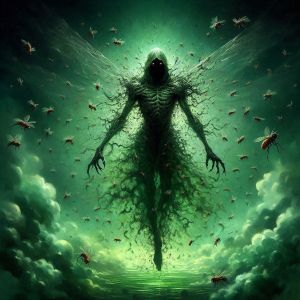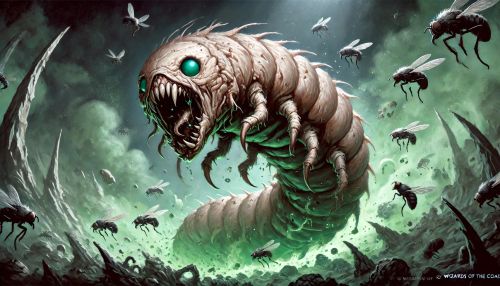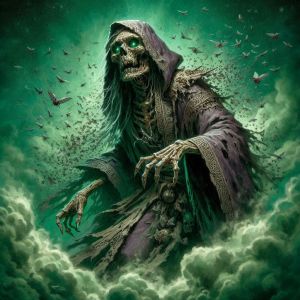Thonoxum: Difference between revisions
No edit summary |
No edit summary |
||
| Line 83: | Line 83: | ||
As the initiate drinks the potion, the cleric recites incantations invoking Thonoxum’s blessing. The initiate pledges their life to the spread of decay and the pursuit of the ultimate plague. The cleric then waits, usually about an hour, to see if the initiate resists the infectious potion. If they do, the cleric casts the initiation spell, thus transforming the initiate into a full follower of Thonoxum. | As the initiate drinks the potion, the cleric recites incantations invoking Thonoxum’s blessing. The initiate pledges their life to the spread of decay and the pursuit of the ultimate plague. The cleric then waits, usually about an hour, to see if the initiate resists the infectious potion. If they do, the cleric casts the initiation spell, thus transforming the initiate into a full follower of Thonoxum. | ||
[[Category:Faiths and Pantheons]] | |||
[[Category:Deities]] | |||
Latest revision as of 07:48, 12 August 2024

Thonoxum, deity of plagues and diseases, views illnesses as catalysts for accelerating the world’s decay into a realm of suffering and foulness. His actions are meticulously calculated to push change towards a festering state of despair, ensuring that suffering permeates every corner of existence. He believes that through this decay, he can reshape the world into his vision of ultimate despair. Driven by an insatiable curiosity, Thonoxum delights in experimenting with new forms of illnesses, watching the suffering they cause with a twisted sense of fascination. He is captivated by the effects of diseases and plagues on various forms of life, finding perverse pleasure in observing how creatures and societies adapt or crumble under the weight of his afflictions.
He takes a perverse pride in his work, and sees himself as an artist of suffering. Each affliction he creates is a masterpiece, meticulously designed to challenge the minds and bodies of those it infects. Pain and despair are his mediums, and he crafts his diseases with the precision and care of a true master, ensuring that each one serves to further his dark vision. Relentless and unyielding, Thonoxum is tireless in his pursuit of spreading disease and decay. He does not rest, constantly seeking new ways to introduce illness into the world. His followers see him as an unstoppable force, a deity whose will cannot be denied or thwarted. His unwavering determination ensures that his influence continues to grow, spreading suffering wherever he turns his gaze.
Thonoxum embodies despair and hopelessness. He revels in the fear and helplessness that plagues and diseases bring to mortals. His presence is often felt as a chilling aura of inevitability, making those who encounter him or his work feel that resistance is futile. This aura is a constant reminder of the inexorable spread of his influence, a harbinger of the decay he so eagerly fosters. In his relationship with his followers, Thonoxum practices a twisted form of favoritism. He grants knowledge and protection to those who show unwavering devotion and usefulness, but his favor is hard to earn and easy to lose. This selective favoritism ensures that his followers remain desperate and loyal, always striving to prove their worth in the hopes of gaining his dark blessings.
Thonoxum is a force of nature, a relentless deity who views the world as a canvas for his art of suffering. His calculated actions, insatiable curiosity, and selective favoritism create a web of despair that entangles all who fall under his influence, ensuring that his vision of a decayed, suffering world slowly becomes reality.
Thonoxum likes to show himself as a ghoulish shadow, his visage obscured by a tattered hood. Through the darkness, only two greenish pinpoints pierce through, casting an eerie, malevolent glow. His body, draped in decay, is a ghastly sight, with twisted veins and necrotic flesh barely clinging to his skeletal frame. From his back sprout two fly-like wings, buzzing with a life of their own, adding to his otherworldly presence. Surrounded by a cloud of greenish miasma, Thonoxum exudes an aura of despair and corruption. All kinds of flies swarm around him, drawn to his festering essence, their incessant buzzing a chilling symphony of decay. The air is thick with the stench of death, and the very sight of him brings an overwhelming sense of dread, as if the world itself recoils from his presence.
He also appears as a gigantic, flesh-eating ghoulish maggot. His grotesque, writhing body is a sickly, pale hue, glistening with a nauseating sheen. His mouth, lined with razor-sharp, gnashing mandibles, capable of tearing through flesh with horrifying ease. This monstrous form is surrounded also by a thick cloud of putrid miasma, and the ground beneath him seems to rot away, unable to withstand the sheer corruption he embodies.
Symbol
Thonoxum's symbol is a macabre and foreboding emblem: a skull surrounded by writhing maggots. The skull, representing death and decay, is intricately detailed with cracks and age marks, symbolizing the ancient and malevolent nature of Thonoxum. The maggots crawling around and within the skull signify the relentless spread of disease and corruption, embodying Thonoxum's domain over plagues and foulness. This gruesome image serves as a powerful reminder of his influence and the inevitable decay that follows in his wake.
Relations With Other Deities
Thonoxum's relentless pursuit of the perfect form of disease creates a suffering that no deity in the good pantheon can ignore. Every god and goddess of light and benevolence views him as a dire threat to the very fabric of the multiverse. This enmity is especially intense with Brigit, the goddess of medicine and healing. She greatly despises Thonoxum, as his ceaseless creation of new maladies directly challenges her divine mission. For Thonoxum, Brigit's healing abilities are not just an obstacle but a tantalizing challenge; he yearns to craft an illness that even she cannot cure.
Among the neutral pantheon, Thonoxum evokes a spectrum of reactions. Some deities, like Aios, the god of balance, regard him as a necessary, albeit dangerous, force. Aios understands that decay is part of the cosmic cycle, but believes that Thonoxum must be closely monitored to prevent his plagues from tipping the scales too far towards destruction. Conversely, deities such as Edmer, the god of nature, and Velthar, the god of beasts, view Thonoxum with outright hostility. They see him not as a balancer but as an existential threat, one who seeks to unravel the natural world and bring about untold devastation.
Within the pantheon of dread, Thonoxum stands out as a figure of dark independence. Unlike many others, he has rejected the leadership of Tiamat, choosing instead to align himself with the enigmatic and ancient knowledge of Nessus. This alliance has proven beneficial, granting Thonoxum access to secrets and arcane lore amassed over the ages. In return, he lends his own expertise in pestilence and decay to further the insidious aims of his dark ally.
What The Legends Say
This is in a state of significant expansion or restructuring We hope we can have this content ready soon. |

Dogma
Thonoxum's dogma is detailed by it's five tenets:
- Embrace the Inevitable Decay: Followers of Thonoxum must accept that decay and disease are natural and inevitable parts of existence. They should not shy away from the sight of rot or illness but see it as a manifestation of Thonoxum's divine influence and a necessary force in the cycle of life and death.
- Spread the Seeds of Suffering: Devotees are charged with the duty to spread diseases and pestilence in Thonoxum's name. Whether through subtle acts or grand schemes, they must ensure that the touch of their deity reaches as many as possible, fostering an environment where only the strongest survive.
- Pursuit Dark Knowledge: Followers must dedicate themselves to the pursuit of knowledge about diseases and plagues. They are to experiment and innovate, striving to create new, more virulent forms of illness. This quest for the ultimate plague is seen as the highest form of devotion, aligning their work with Thonoxum's eternal challenge against the forces of healing.
- Decay as a Catalyst for Change: Thonoxum's followers must accept that pain and suffering are catalysts for transformation. Diseases and plagues are viewed as engines that accelerate the decay of the world into a realm of foulness and suffering. By embracing and inflicting pain, they help to manifest Thonoxum's vision of a decayed and corrupted world.
- Decay as a Path to Despair: Followers are taught that through embracing and spreading decay, they can lead others into ultimate despair. The sight and smell of rot are powerful tools to break the spirit and will of even the strongest beings. By fostering decay, they pave the way for a world immersed in hopelessness, aligning with Thonoxum’s desire to see all life succumb to misery.
Clergy and Temples

The clergy of Thonoxum are a twisted and feared group, composed mostly of perverted individuals drawn from the outcasts of society, even within regions dominated by evil influence. They primarily come from spellcaster classes, especially necromancers, and include members from many races. Their ranks even count some powerful undead among them, adding to their terrifying reputation. These dark priests dress in ornamented dark robes over skin-tight leather outfits, which offer some protection against the numerous diseases they handle. Full face masks, often decorated with dark symbols, are also common, further shrouding their identities and adding to their ominous presence.
Despite their small numbers, the members of Thonoxum's clergy are dreaded for their forbidden knowledge and necromantic abilities. Their organization is simple yet functional, with a hierarchy based primarily on magical power. They are infamous not for seeking knowledge for good, but for the opposite: they delve into dark research to create stronger, more infectious, and more resistant plagues and diseases. This relentless pursuit of darker, deadlier pathogens drives them to push the boundaries of necromantic science and magic.
Their hands-on approach to research often leads to devastating consequences. Entire settlements can be wiped out when a group of Thonoxum's clerics establish a research center nearby. The life expectancy within the clergy is notably short due to the dangerous nature of their work. As a result, the more powerful clerics who survive long enough often choose the path of unlife to continue their research without fear of all but the most powerful magical infections. These undead clerics are the epitome of Thonoxum's teachings, immortal carriers of his blighted wisdom.
Other members of the clergy take upon themselves the duty of spreading diseases, becoming living carriers of illness. These clerics travel in disguise, their lives often cut short by the very plagues they propagate. However, they offer their lives to Thonoxum with the belief that they will be rewarded in the afterlife. Wherever they go, members of Thonoxum's clergy are shunned and feared, even in regions where evil prevails. The presence of a Thonoxum cleric signifies impending doom, a harbinger of decay and suffering that leaves a trail of death in their wake.
Thonoxum's temples are often hidden away in remote, desolate areas far from populated regions. Swamps, deep dark forests, and abandoned ruins are common sites, providing natural cover and isolation for their dark activities. Many temples are located underground, accessed through hidden entrances or beneath derelict buildings, offering secrecy and protection from prying eyes. Some temples are established near areas already afflicted by disease or decay, such as mass graves, or cities hit by plague. These locations provide ample subjects for research and a natural environment for their work.
The architecture of Thonoxum's temples is deliberately eerie and unsettling. Dark stone and bone are common materials, with walls often adorned with carvings of suffering and decay. The designs are intended to instill fear and dread in any who enter. Within the temples, there are extensive laboratories dedicated to the study and creation of diseases. These labs are equipped with vials of infectious agents, specimens of various plagues, and dark alchemical tools. The air is thick with the scent of rot and the hum of flies. To facilitate their research on pain and suffering, many temples contain torture chambers where unfortunate victims are subjected to various diseases. These rooms are equipped with implements of torment and are often the site of gruesome rituals. Temples also house extensive libraries filled with forbidden knowledge on necromancy and disease. Ancient tomes, scrolls, and grimoires line the shelves, providing clerics with the information needed to further their dark goals.
Initiation
Would-be followers of Thonoxum are always depraved individuals who don't quite fit into any society, primarily because of their tendency to see others as disposable. When one of these outcasts manages to contact a member of the clergy, they can request initiation. Ideally, this should happen one year before the would-be follower's coming of age to avoid the risk of becoming a Soulstray. Once the initiation request is accepted, the year-long preparation begins.
During this preparation, the initiate receives forbidden knowledge necessary to serve Thonoxum properly. They assist in the dark research conducted by the clergy, a perilous endeavor as they might become infected with the very diseases they study, potentially leading to a painful death. It is even common for clerics to use initiates as test subjects. Resisting a disease is taken as an indication of Thonoxum's favor towards the initiate.
Each day, the initiate must meditate for at least one hour, reflecting on the day's deeds. This practice reinforces their alignment with Thonoxum’s dark dogma and their commitment to spreading decay and disease. On the final day of preparation, the initiate spends the entire day in solitude, contemplating the suffering they have caused, the decay they have witnessed, and how these acts further Thonoxum's vision of a world steeped in disease and despair.
The next day, at midnight, the initiate presents themselves at the unholy altar of the temple, before a cleric. The cleric conducts the ritual by anointing the initiate with a concoction of diseased fluids and ash from decayed bodies. The initiate is required to drink a part of this potion, which can kill them almost immediately. Being able to resist it is seen as a symbol of acceptance of Thonoxum's gifts and their readiness to spread his influence.
As the initiate drinks the potion, the cleric recites incantations invoking Thonoxum’s blessing. The initiate pledges their life to the spread of decay and the pursuit of the ultimate plague. The cleric then waits, usually about an hour, to see if the initiate resists the infectious potion. If they do, the cleric casts the initiation spell, thus transforming the initiate into a full follower of Thonoxum.

